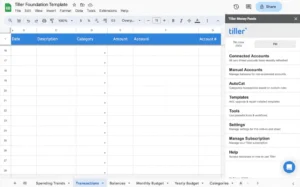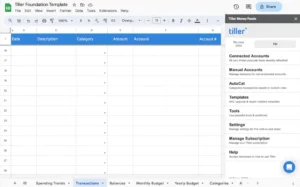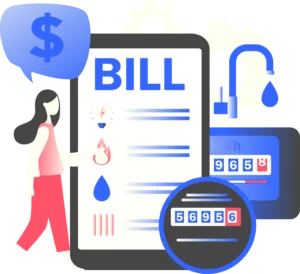Managing your finances effectively is vital to achieving financial stability and meeting long-term goals. With technology offering tools for every aspect of life, Google Sheets remains a simple yet powerful aid for personal finance management. This versatile platform simplifies budgeting and expense tracking and offers customizable options to fit individual financial situations.
Advertisements
Getting started with Google Sheets for personal finance

Google Sheets offers a flexible and accessible solution for anyone looking to keep track of income and organize their finances. Whether you are planning a budget, tracking investments, or monitoring expenses, Google Sheets can cater to all your financial planning needs. Here's how to get started.
Creating your first budget spreadsheet
Begin by opening Google Sheets and selecting a blank spreadsheet. With your new Google Sheet, you can manually input categories such as ‘Income,' ‘Expenses,' ‘Savings,' etc., or use pre-existing free budget templates to get a head start. Your categories should cover auto insurance, credit card balances, and other necessary information. Remember, a simple monthly budget template might be the best option for your situation.
Customization for personal finance needs
While Google Sheets comes with basic personal finance templates, platforms like TillerHQ and Smartsheet provide advanced templates for specific needs that automatically pull transactions from your bank accounts, categorize them, and offer a real-time view of your financial health for the designated budget period (such as the end of each month).
Choosing the right template for your needs

The key to effective financial planning in Google Sheets is selecting a budget planner template that aligns with your financial goals and lifestyle. Decide whether you need a straightforward budget tracker or a comprehensive financial planner with debt tracking, savings goals, and investment monitoring.
Monthly budgets are ideal for managing day-to-day expenses and income. Debt tracking worksheets help organize and plan a payoff strategy. A savings goals sheet sets and tracks progress toward specific savings targets.
Resources like Rise Credit, TillerHQ, and Smartsheet offer a variety of templates catering to different financial management styles and needs. Tiller recently posted a video about optimizing your finances in 2024.
Tailoring templates to fit your financial picture

Customizing a template to reflect your financial picture is crucial once you've chosen a template. Here are steps to tailor the templates:
- Modify categories: Add or remove categories to match your income sources and spending habits. This might include categories specific to your situation, like ‘Freelance income,' ‘Childcare expenses,' or ‘Travel savings.'
- Adjust formulas: If your template calculates totals or averages, ensure the formulas encompass all the relevant cells. You might need to adjust these as you add or remove categories.
- Dashboard creation: Consider setting up a dashboard within your spreadsheet for an overview of your financial health. This can include summaries of your expenses, income, savings, and debts all in one place. It is imperative to have a graphical representation with a user-friendly interface of your income, daily expenses, and how much cash you have weekly. Google Sheets can become a highly personalized tool that offers insights into your financial health and helps you make informed decisions.
Advertisements
Advanced tips and techniques
Enhancing your Google Sheets for personal finance involves incorporating advanced techniques and tools that streamline processes and provide deeper insights. Here's how to elevate your financial tracking.
| Technique | Description | Application |
| Automation | Use Google Sheets' built-in functions like `IMPORTXML` and `GOOGLEFINANCE` | Automate data import, including stock prices or bank transactions, reducing manual entry |
| Google Apps Script | Use basic Google Apps Script to automate repetitive tasks | Categorize monthly transactions and set budget reminders |
| Data visualization | Transform your data into visual charts and graphs to clearly understand your financial trends over time; visualize spending habits and investment growth | Use the `Insert > Chart` feature to get started |
Maintaining your personal finance spreadsheet

Regular maintenance is critical to ensuring your Google Sheets budget remains an effective tool for financial management. Here are strategies to keep your spreadsheet accurate and up to date:
- Monthly reviews: Set aside time to review and categorize transactions, update savings goals, and adjust budgets as needed.
- Reconcile with bank statements: Regularly compare your spreadsheet figures with your bank and credit card statements to catch any discrepancies. Our recommended all-purpose credit card is the Rogers Red Mastercard. It's our favourite pick as a no fee, generous cash back credit card that is suited for all types of users. Existing customers with any Rogers or Fido services such as cellphone, internet or cable get to enjoy increased cashback as well.
- Legal Terms
- Standard rate on Purchases and Fees: 20.99% Standard rate on Cash Advances, Cash-like Transactions and Balance Transfers: 22.99%. If you are not approved for an Account at the above rates and you reside outside Quebec, we may still issue you an Account at our alternate interest rates, as follows:
- Rate for Cash Advances, Cash-like Transactions and Balance Transfers: 27.99%
- Rate for Purchases and Fees: 25.99%
- Standard rate on Purchases and Fees: 20.99% Standard rate on Cash Advances, Cash-like Transactions and Balance Transfers: 22.99%. If you are not approved for an Account at the above rates and you reside outside Quebec, we may still issue you an Account at our alternate interest rates, as follows:
Monthly maintenance checklist
Adding the following monthly tasks to your personal finance routine will provide you with exceptional clarity and results:
- Update all transactions and categorize them.
- Check for and correct any formula errors.
- Review budget categories for necessary adjustments.
- Reconcile account balances with bank statements.
- Update savings and investment totals.
Advertisements
Beyond budgeting: Other financial planning uses for Google Sheets
Google Sheets can be a comprehensive tool for all aspects of financial planning beyond just budgeting. Consider these additional uses.
Investment tracking
Set up a sheet to track your investment portfolio performance, including stocks, bonds, and mutual funds. Check out our free guide for our recommended investing platform here to learn more about starting and managing your investment portfolio.
Tax preparation
Create a dedicated spreadsheet for tracking deductible expenses, income sources, and tax-related documents throughout the year.
Goal planning
Google Sheets is essential for setting financial goals, such as saving for a house or planning for retirement.
When using Google Sheets for personal finance, it's crucial to ensure your sensitive financial information remains secure:
- Limit sharing: Only share your financial spreadsheet or other digital file with trusted individuals and use Google Sheets' sharing settings to control their access level.
- Two-Factor Authentication (2FA): Enable two-factor authentication on your Google account for an added layer of security.
- Regular backups: Consider making regular backups of your financial spreadsheets to prevent data loss.
Privacy tips
The following tips are helpful when securing your Google Sheets data:
- Regularly review and update your Google account's security settings.
- Be cautious of third-party add-ons and their access to your user data.
- Use anonymous sharing options when sharing sheets for feedback or help.
Rich Dad Poor Dad book recommendation
A great book we recommend that compliments building a budget is Rich Dad Poor Dad by Robert Kiyosaki. The book emphasizes the importance of financial education, investing in assets, and creating multiple income streams to achieve financial independence. It is widely considered one of the most influential personal finance books of all time, inspiring readers to think about money and investing differently. Many of the articles we publish are inspired by principles Robert emphasizes. Get a copy of it here for yourself, or better yet, a gift to someone to improve their financial education.
Consistent tracking and adjustment is key
With tools like Google Sheets, organizing and managing your financial life becomes significantly more manageable. From creating custom budget templates to tracking investments and planning for future goals, Google Sheets offers the flexibility and functionality to cater to virtually any financial need.
Leveraging the power of automation, data visualization, and regular maintenance can help you transform your approach to personal finance, making it easier to monitor your progress and make informed decisions. Remember, the key to financial management is tracking progress and consistently evaluating and adjusting to align with your goals.
Make Creditpicks a part of your financial journey
For more helpful personal finance tips and access to exclusive partner offers, visit Creditpicks regularly. We provide the tools and insights you need to make the most of your financial journey.
Advertisements




